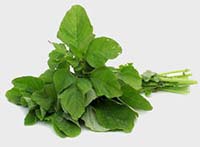Selection and storage
 |
| Amaranthus dubius. Notice deep green leaves. |
Amaranths are short seasonal annual crops, with leaves ready for harvesting about 4-6 weeks after sowing the seeds.
Leafy-vegetable amaranths thrive in day temperatures above 25°C and night temperatures not lower than 15°C. They prefer fertile, free-drained alkaline soils.
In the tropics, amaranth greens are available year-round. When purchasing from markets, look for fresh leaves packed in bunches with deep-green or variegated color, displaying vitality and crispiness. Avoid wilted leaves, yellow discoloration, and spots, as well as those that are overly large and thick-stemmed, as they can be excessively bitter.
Upon arriving home, vigorously wash amaranth in a bowl of cold water, swishing thoroughly several times to remove any sand or dirt.
Preparation and serving methods
To prepare, separate the leaves and thick stems, reserving the stems to cook separately which may take longer to cook.
Wash leaves in cold water before using them in cooking. Gently pat them dry using a tissue/soft cloth or swish them a few times in the air.
Fresh leaves can be either chopped or used as they are in a variety of recipes. Extended cooking may result in the loss of nutrients, particularly antioxidants and vitamins.
Here are some serving tips:
-
You can enjoy fresh, tender leaves and shoots either raw in salads or juiced.
-
In the Caribbean, amaranth greens are commonly known as callaloo and are a key ingredient in the popular “callaloo soup,” made with taro, ham hocks, jalapeno peppers, celery, okra, coconut milk, and crabmeat.
-
In mainland China, where the greens are known as yin-choy (苋菜, A. tricolor or Chinese spinach), they are often used in stir-fries and soups.
-
In the Indian subcontinent, the greens are referred to as chaulai (चौलाई) and are widely used in curries, stews, and mixed vegetable dishes.
-
In Greece, amaranth greens are popularly known as vlita and are boiled with other well-known green leafy vegetables like dandelion, mustard greens, chicory greens, etc. They are dressed with extra virgin olive oil and a squeeze of lemon juice, and served as the dish vrasta chorta.
Safety Profile
Amaranth greens, akin to spinach, contain elevated levels of oxalic acid (1.09 g/100g), a naturally occurring substance found in select vegetables. In some individuals, oxalic acid may precipitate as oxalate stones in the urinary tract.
Those with a history of oxalate urinary tract stones are advised against consuming certain vegetables from the Amaranthaceae and Brassica families. Maintaining adequate water intake is recommended to support normal urine output.
The presence of phytates and dietary fiber in the leaves can potentially hinder the absorption of calcium, iron, and magnesium.
Due to its significant vitamin-K content, individuals on anticoagulants such as “warfarin” are cautioned against incorporating amaranth into their diet as it may affect drug metabolism. (Medical disclaimer).
Also read ≻≻-
≺≺- Grain Amaranth Nutrition facts and health benefits.
≺≺- Back to Vegetables from Amaranth greens. Visit here for an impressive list of vegetables with complete illustrations of their nutrition facts and
health benefits.
≺≺- Back to Home page.
Further reading:
-
USAID.GOV -Pdf-(Link opens in new window).
-
USDA National Nutrient Database.(Link opens new window)
-
Amaranth-Purdue University Education. (Link opens in new window).
-
Oxalic content of selected vegetables. (Link opens in new window).

